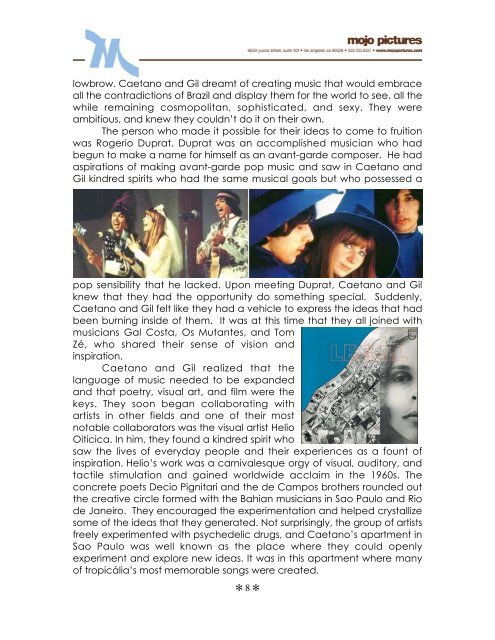a feature length documentary proposal - Mojo
a feature length documentary proposal - Mojo
a feature length documentary proposal - Mojo
You also want an ePaper? Increase the reach of your titles
YUMPU automatically turns print PDFs into web optimized ePapers that Google loves.
lowbrow. Caetano and Gil dreamt of creating music that would embrace<br />
all the contradictions of Brazil and display them for the world to see, all the<br />
while remaining cosmopolitan, sophisticated, and sexy. They were<br />
ambitious, and knew they couldn’t do it on their own.<br />
The person who made it possible for their ideas to come to fruition<br />
was Rogerio Duprat. Duprat was an accomplished musician who had<br />
begun to make a name for himself as an avant-garde composer. He had<br />
aspirations of making avant-garde pop music and saw in Caetano and<br />
Gil kindred spirits who had the same musical goals but who possessed a<br />
pop sensibility that he lacked. Upon meeting Duprat, Caetano and Gil<br />
knew that they had the opportunity do something special. Suddenly,<br />
Caetano and Gil felt like they had a vehicle to express the ideas that had<br />
been burning inside of them. It was at this time that they all joined with<br />
musicians Gal Costa, Os Mutantes, and Tom<br />
Zé, who shared their sense of vision and<br />
inspiration.<br />
Caetano and Gil realized that the<br />
language of music needed to be expanded<br />
and that poetry, visual art, and film were the<br />
keys. They soon began collaborating with<br />
artists in other fields and one of their most<br />
notable collaborators was the visual artist Helio<br />
Oiticica. In him, they found a kindred spirit who<br />
saw the lives of everyday people and their experiences as a fount of<br />
inspiration. Helio’s work was a carnivalesque orgy of visual, auditory, and<br />
tactile stimulation and gained worldwide acclaim in the 1960s. The<br />
concrete poets Decio Pignitari and the de Campos brothers rounded out<br />
the creative circle formed with the Bahian musicians in Sao Paulo and Rio<br />
de Janeiro. They encouraged the experimentation and helped crystallize<br />
some of the ideas that they generated. Not surprisingly, the group of artists<br />
freely experimented with psychedelic drugs, and Caetano’s apartment in<br />
Sao Paulo was well known as the place where they could openly<br />
experiment and explore new ideas. It was in this apartment where many<br />
of tropicália’s most memorable songs were created.<br />
8


